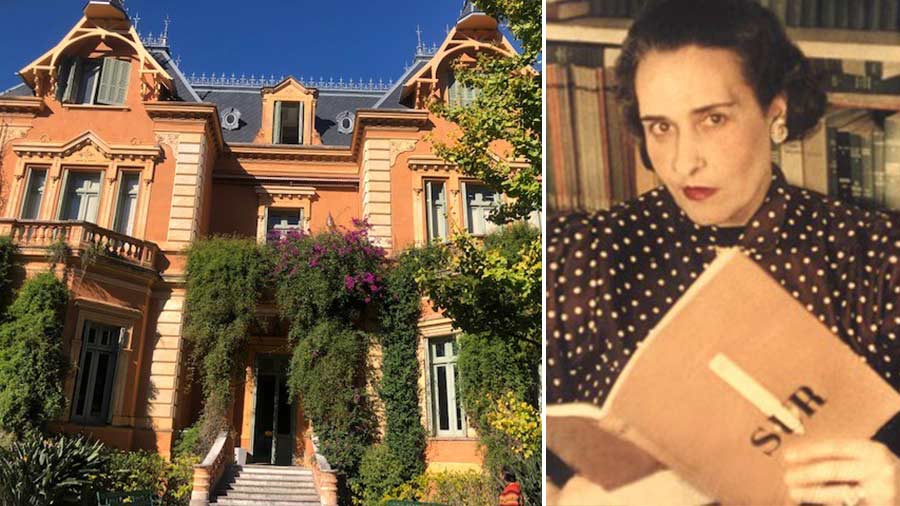“Going to the country of Maradona and Messi – are you a football fan?” asked the tall blonde visa officer when my wife and I went for our interview at the Embassy of Argentina in New Delhi. I said sheepishly, “That is very interesting, but Messi is not living in Argentina and so our interest is to visit the villa of Victoria Ocampo in San Isidro!” This was greeted by silence as the officer took time to connect the Ocampo dots.
Victoria Ocampo, not known to many Indians or Argentines, was not only a writer but she also took Argentine literature beyond her country, to Europe and the USA. She was the founder of the literary magazine ‘Sur’, that published poems, essays, short stories and commentaries.
It was on November 6, 1924 that Rabindranath Tagore’s voyage to Peru had to stop in Buenos Aires as he was down with influenza and needed urgent medical attention. Tagore checked into the Plaza Hotel in Buenos Aires. He was then 63 and the doctor strongly advised against a rather tedious train ride through the Andes in a cross-country journey to Lima in Peru.
Victoria discovered Tagore through the works of Rolland
Around the same time, a young local poet Victoria Ocampo residing in Buenos Aires, had learnt a lot about Tagore and his philosophy of life through the works of Romain Rolland. She had also read Gitanjali’s French translation by Andre Gide. It was the time when her marriage with a well-known Argentine lawyer was ending. In her own words, the poems of Gitanjali were “like celestial dew falling on my anguishing 24-year-old heart”. She described Tagore’s poems as “magical mysticism”. She seemed to connect instinctively with his spiritual love – the belief of loving a personal god who is also manifest as the beloved but remains in a dark chamber. His poems influenced her deeply, imbuing in her a sense of serenity, happiness and sorrow.
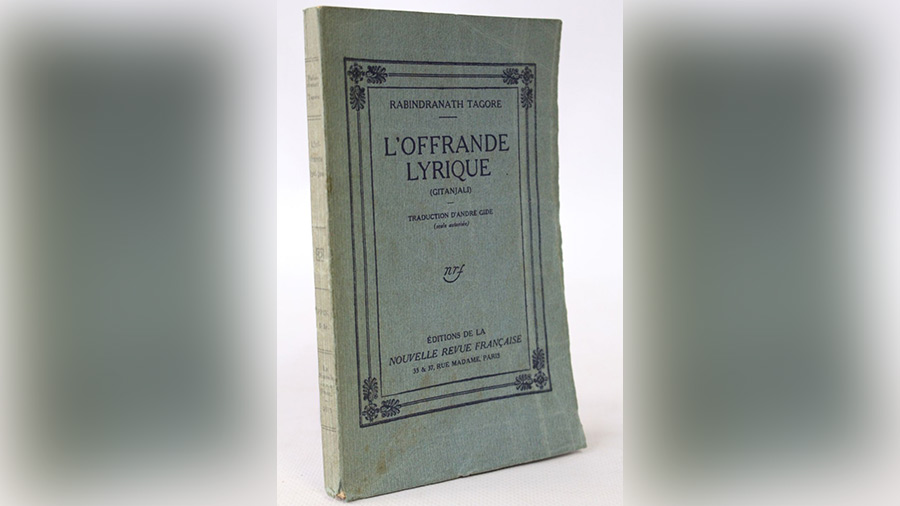
The cover of Gitanjali’s French translation by Andre Gide
Victoria was desperate to meet Tagore and offered to take him to her country home in San Isidro, a suburb of the city of Buenos Aires for peaceful and undisturbed recuperation in a serene environment. She looked after Tagore with utmost devotion during his 58 days’ sojourn.
Victoria and Tagore were to meet again six years later in Paris. She had inspired him to paint at a late stage of his life and the painting exhibition held in Paris, won him a lot of acclaim.
The serene ‘Miralorio’ overlooking river Plata, where Tagore wrote of love and longing
Coming back to San Isidro, it is a tiny hamlet, located very close to the hustle and bustle of Buenos Aires and yet so serene with small, tree-lined streets and riverside villas. Victoria invited the poet to her parents’ home in San Isidro which stands today as Villa Ocampo, a UN Heritage site of education and culture. The story would not be complete without mentioning that the parents of the young poet Victoria were not in favour of Tagore staying in their villa. Victoria then had to raise funds and is believed to have sold her tiara to rent a quaint villa belonging to one of her relatives, about four blocks away atop a highland, overlooking the river Plata.
This is the villa known as ‘Miralorio’ that offers a view of the gently flowing river Plata sneaking from the slopes of the garden. It is not difficult to comprehend that the picturesque scenic views and the occasional presence of Victoria inspired Tagore to compose some of his immortal lyrics on love and longing. He composed about 30 poems during this period. Most of these are included in the collection of poems Purabi, the book that he dedicated to his beloved ‘Bijoya’ or Victoria. The tone of the “missing” manifested in many of his later works, may have originated from Miralorio.
Prabhat Kumar Mukhopadhyaya, the well-known biographer of Tagore, believed that the sense of “missing” lingered in his mind till the end. Some 14 years after his meeting with Victoria, he dedicated the lyrics ‘Ogo amar chiro achena pardesi” to his ‘Bijoya’.
My ever unknown stranger,
Do not know what invited you to me,
I do not understand your language
But your mood is playing in heart in the captivating melody of someone’s flute
Victoria is known to have exclaimed, “You speak in a language that I do not understand, but your mood plays in my heart….”
Villa Ocampo: UN heritage site visited by Nehru and Indira
It took us about an hour from downtown Buenos Aires to reach Villa Ocampo in a local taxi. The first disappointment was that we seemed to have reached about a year late! The caretaker of Villa Ocampo informed us that ‘Miralorio’ had been demolished about a year ago by a property developer. We could see the inevitable march of urbanisation in this peaceful village. Villa Ocampo today stands gorgeously as a UN heritage site, surrounded by beautifully manicured gardens and well-laid-out array of fountains. Not many visitors come here and thus we almost had the whole place to ourselves.
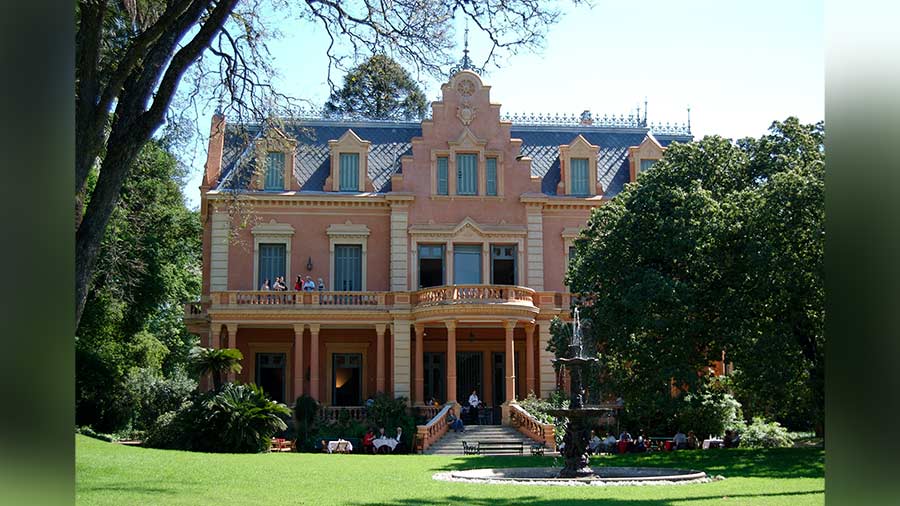
Villa Ocampo today stands gorgeously as a UN heritage site, surrounded by beautifully manicured gardens Wikimedia Commons
Villa Ocampo is a brick-coloured stone building with a simple façade, offering a cosy feeling as we enter. A straight steep staircase welcomes the visitors to the first floor where all the memories of Victoria and her many celebrity guests linger.
Besides Tagore, many distinguished guests visited the place at the invitation of Victoria. The main study is filled with a grand piano – a testimony to her love for music. Photographs of some celebrity guests occupy the mantlepiece. One of them is composer Igor Stravinsky, who created ‘Rites of Spring’. We were told that Victoria wanted to be a soprano singer and thus was keen to be acquainted with the famous composer.
Other luminaries who spent time here are literary giants Graham Greene and Albert Camus, and the Swiss French architect Le Corbusier (also the designer of the city of Chandigarh). The photo frames of Jawaharlal Nehru and Indira Gandhi find pride of place – both of our former Prime Ministers having visited Villa Ocampo because of the Tagore connection. There is another nugget of political history binding Nehru and Villa Ocampo. When Victoria was arrested by the then President Juan Peron, in 1950, because of her free and critical views against the government, Nehru wrote a strong letter of condemnation. Peron was at that time determined to include Argentina in the Non-Aligned group and so could not reject Nehru’s views on Victoria’s incarceration.
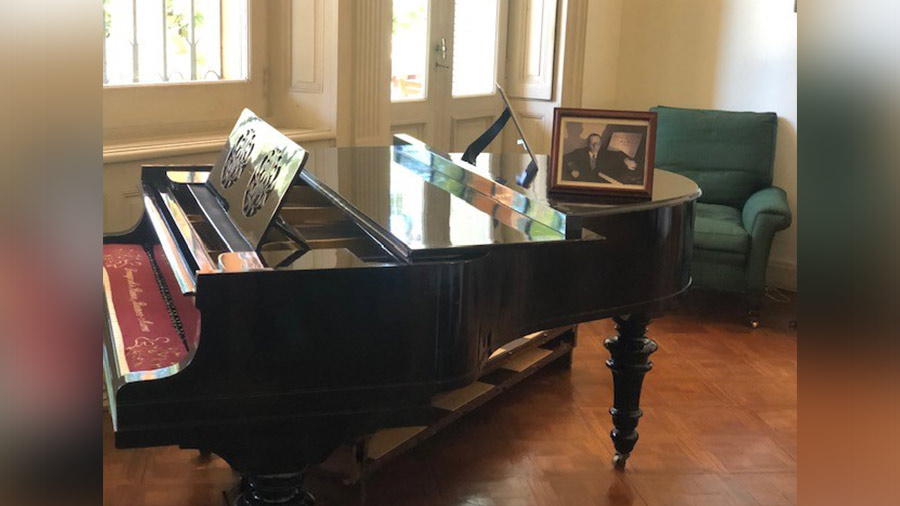
Ocampo’s grand piano
The inscription on the first page was from Tagore in his own hand, in Bengali, gifting the book to his ‘Bijoya’
Le Corbusier was later commissioned by Victoria to build a house which today symbolises artistic expressions of all regions of Argentina, located in an upscale neighbourhood of Palermo Chico in Buenos Aires. I must observe that a commercial tour of the city does not make a stop there.
The Villa Ocampo today stands as a museum and is very well preserved with funds coming in from the United Nation. It houses a huge library on the upper floor where researchers are welcome to spend time. The librarian was enthused when she learnt that we were from the land of Tagore and that we could tell her all about Santiniketan. She was a Tagore scholar but had never been to India. She suddenly disappeared and brought out an old book from the archive, holding it carefully. The inscription on the first page was from Tagore in his own hand, in Bengali, gifting the book to his ‘Bijoya’.
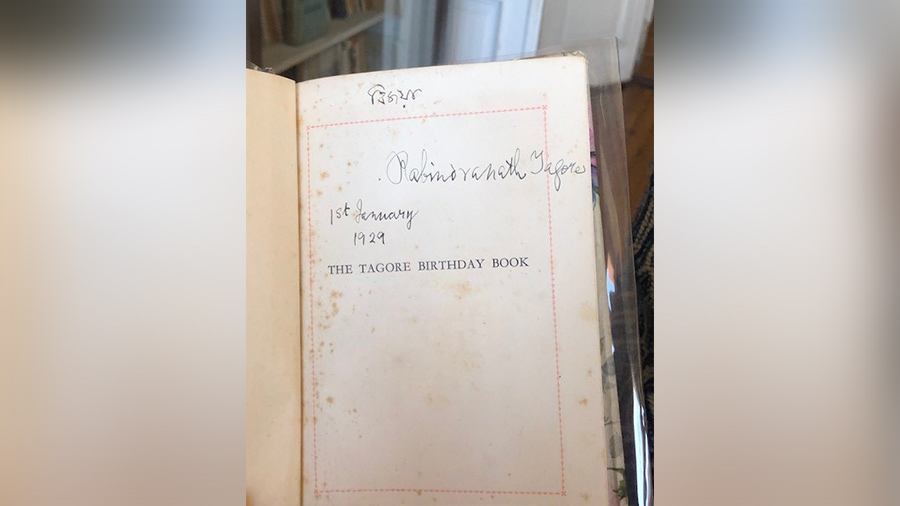
Tagore’s gift to his ‘Bijoya’
In 1925, Tagore dedicated his collection of poems called Purabi to ‘The Lotus Palms of Bijoya’. Years later, Victoria wrote: “Now, tell me what is the title of the poetry book you dedicated to me?” “It is named Purabi – the East in its feminine gender!” replied Tagore.
Purabi mirrored a remarkable phase of Tagore’s poetic life touched by his ‘Bijoya’. He likened his San Isidro sojourn to being on a treasure island detached from the realities of everyday life. This was not the Tagore that the West knew through his Nobel-winning Gitanjali. The villa Miralorio was witness to a transformation of the poet.
Thinking of Him: Victoria’s words when she learnt of Tagore’s passing
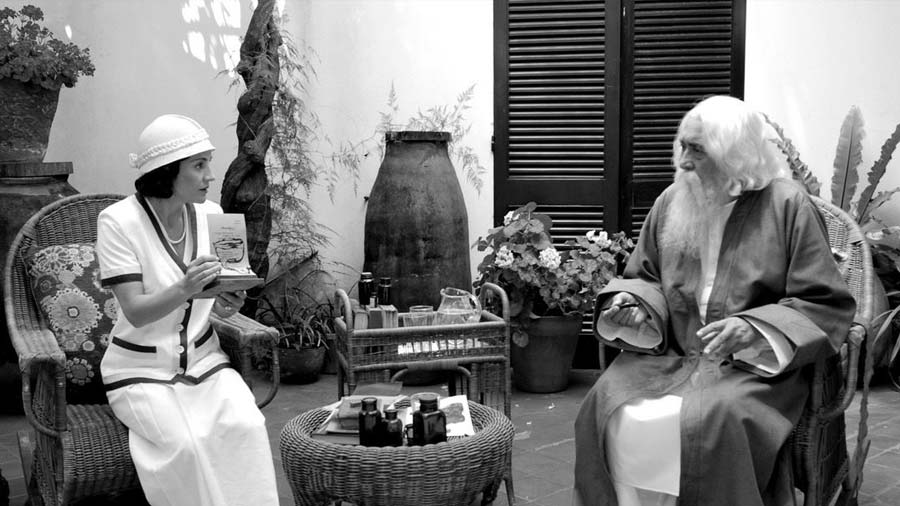
Eleonora Wexler as Victoria Ocampo and Victor Banerjee as Rabindranath Tagore in ‘Thinking of Him’
The recent film in Spanish by Pablo Cesar, Thinking of Him, was shot here a few years ago. Victor Banerjee acted in the role of Tagore. It is sad that the movie was never released for public viewing. The librarian at Villa Ocampo and some other scholars there told us passionately about the film shoot. The title of the movie relates to the fabled one liner – “Thinking of Him” – that comprised Victoria Ocampo’s telegram response to the news of Tagore’s passing.
As for the Bard, if the poems in Purabi reflect an overwhelming feeling of longing, on November 21,1924 his composition of ‘Sesh Basanta’ (The Last Spring), says it all:
“You will experience many springs in your life,
Let me beg one of it…
Have no misgivings;
In your blossoming flower garden
I’ll not linger endlessly
Nor look back
When the day ends and it’s time for leave-taking.”
The last rays of the sun fought a losing battle with the blanket of darkness descending on San Isidro, leaving us with a feeling of separation as we started our journey back to Buenos Aires.
Indrajit Mookerjee is a graduate from IIT Kharagpur and Georgia Institute of Technology, Atlanta, USA. He has been the Country Head (India) of Praxair Inc (now Linde). Presently, he is the Vice Chairman of a Heavy Engineering company belonging to a large Indian group. Travelling and reading are his passions.
